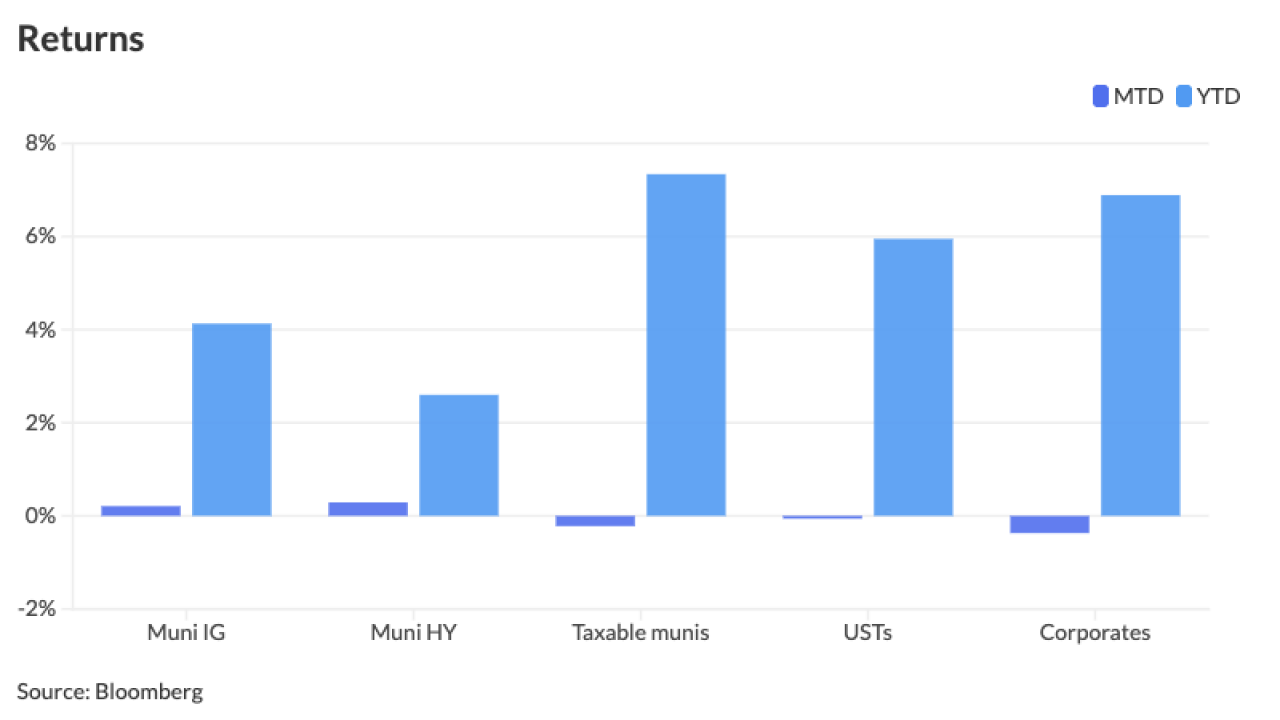Munis were a touch firmer out long in Wednesday's trading, as U.S. Treasury yields fell and equities ended up.
The two-year muni-UST ratio Tuesday was at 65%, the five-year at 63%, the 10-year at 71% and the 30-year at 89%, according to Municipal Market Data's 3 p.m. EDT read. ICE Data Services had the two-year at 62%, the five-year at 61%, the 10-year at 70% and the 30-year at 89% at a 3 p.m. read.
The Investment Company Institute Wednesday reported inflows of $1.114 billion for the week ending Sept. 24, following $1.138 billion of inflows the previous week. This is the third consecutive week that inflows topped $1 billion.
Exchange-traded funds saw outflows of $145 million after $953 million of inflows the week prior, per ICI data.
The municipal market had a subdued reaction to the government shutdown on Wednesday, primarily responding to the strength in USTs, which, in turn, was due to the private payroll data bolstering the odds of another Federal Reserve rate cut later this month.
Municipal credits face "minimal" risk from the latest government shutdown, but any disruption to key economic data releases "could increase market uncertainty and complicate monetary policy decisions" and "cloud the economic outlook," said Tom Kozlik, managing director and head of public policy and municipal strategy at HilltopSecurities.
"Historically, most shutdowns have been short-lived. Even the longest, during the previous Trump administration, lasted 35 days (and was only a partial shutdown) and had little if any meaningful impact on municipal credit quality," he said.
What could make this situation different is the deeper divide between parties and a reduced willingness to compromise, which could lead to a longer disruption, Kozlik said.
Muni credits in regions with a "high concentration" of federal workers may face short-term spending pressures, but Hilltop does not expect lasting damage.
"The underlying fundamentals of most municipal issuers remain strong, and we expect them to weather this period without significant credit stress," Kozlik said.
"The more immediate concern," he said, "is the disruption to key economic data releases, which could increase market uncertainty and complicate monetary policy decisions. With the Fed relying heavily on employment and inflation data, a shutdown that halts agency reporting could cloud the economic outlook."
Elsewhere, following the municipal market's "strongest September performance in over a decade," Lind Capital Partners is urging investors to "rethink complacency" in light of the compelling yield discrepancy between holding lower-yielding taxable cash instruments such as U.S. Treasury bills versus investing in longer-term tax-exempt bonds, which yield much more.
Muni investors "are now faced with a completely new opportunity cost calculus to consider" and "may have run out of time" if they don't act, J. Robert Lind, principal and founder of Lind Capital Partners, said in a monthly commentary
In September, "buoyed by Treasury market stability and favorable technicals, investment grade municipal bonds posted their second consecutive month of positive performance and best September returns since 2009," Lind said.
Munis saw gains of 2.32% in September, bringing year-to-date returns to 2.64%.
The main catalyst was dovish comments by Federal Reserve Chair Jerome Powell at the Fed's Jackson Hole conference, followed by the "ultimate fulfillment of a rate cut," Lind said.
Additionally, munis had a strong month in September due to a slowdown in supply, said Cooper Howard, a fixed income strategist at Charles Schwab.
Issuance last month was at $44.595 billion,
"Despite the strong month, returns for munis still trail most other major fixed income asset classes," Howard said. "We expect returns relative to Treasuries to continue to recover assuming issuance remains in check."
And while September ended with "modest outflows, after five straight weeks of inflows, demand for municipal funds remained robust in September, with total inflows approaching $4 billion," Lind said, noting inflows were largely split between investment grade and high yield, which is notable for high yield, as it represents only a fraction of the overall municipal market.
Looking forward, Lind Capital Partners warned muni investors to avoid the high opportunity cost of "hiding out" in short-term taxable instruments, such as T-bills and money market funds.
Over the past two years, investors did "fairly well" with this strategy, as the annualized total return on one-year T-bills during the period was 4.73%, Lind said.
However, the firm warned, "they are now faced with a completely new opportunity cost calculus to consider."
Two years ago, the firm noted, the yield on one-year T-bills was 5.50%, now nearly 200 basis points lower at 3.60%.
Meanwhile, yields on longer-dated bonds have remained "relatively stable," Lind said.
The 30-year U.S. Treasury bond was yielding 4.70% on Sept. 30, 2023, and now yields 4.73%, he said.
Longer-dated non-rated munis "carried a tax-exempt yield of 7.00% in September 2023 and have tightened very modestly, yielding 6.75% today," Lind said.
"In a stable rate environment, investing in 12-month T-bills generates a 2.07% after-tax total return," Lind said, "not nearly as attractive as it was two years ago.
"Investors are now sacrificing 4.69% per year (after-tax) compared to a 20-year non-rated tax-exempt bond yielding 6.75%. In a modestly declining rate environment, that opportunity cost grows to 6.76% per year (again, after-tax). Investors who have remained in cash alternatives would be wise to consider how these new opportunity costs affect their portfolios and their ability to achieve their long-term goals, " he said.
In the primary market Wednesday, Wells Fargo priced $1.01 billion of Los Angeles Department of Water and Power (Aa2//AA-/AA/) power system revenue bonds, Series 2025C. The issue consisted of 5s of 7/2030 priced to yield 2.83%, 5s of 7.2035 to yield 3.26%, 5s of 7/2040 to yield 3.92%, 5s of 7/2045 to yield 4.34%, 5s of 7/2051 to yield 4.57%, and 5s of 7/2055 to yield 4.62%.
Goldman Sachs priced $960.73 million California Community Choice Financing Authority Clean Energy Project Revenue Bonds Series 2025E (Green Bonds) (Aa2///) as 5s of 5/2034 to yield 3.62% and 5s of 5/2035 to yield 3.78%.
BofA Securities priced $182.545 million revenue and refunding bonds for the North East Texas Regional Mobility Authority. The deal included $134.63 million of Series 2025 senior lien bonds priced as 5s of 1/2026 to yield 2.77%, 5s of 1/2030 to yield 2.83%, 5s of 1/2035 to yield 3.38%, 5s of 1/2040 to yield 4.02%, 5.25s of 1/2045 to yield 4.45%, and 5.25s of 1/2046 to yield 4.50%.
The issue also included $47.915 million Series 2025B subordinate lien revenue refunding bonds priced as 5s of 1/2026 to yield 2.87%, 5s of 1/2030 to yield 2.96%, 5s of 1/2035 to yield 3.54%, 5s of 1/2040 to yield 4.26%, 5.25s of 1/2045 to yield 4.65%, and 5.25s of 1/2046 to yield 4.70%.
J.P. Morgan priced $179.39 million of Series 2025A health care facilities revenue bonds for the Birmingham Special Care Facilities Financing Authority, Alabama, (/AA-/AA-/) (Children's Hospital). The deal included 5s of 6/2030 to yield 2.72%, 5s of 6/2040 to yield 4.03%, 5.25s of 6/2045 to yield 4.42%, 5.25s of 6/2050 to yield 4.56%, and 5.25s of 6/2055 to yield 4.64%.
BofA Securities priced $164.68 million adjustable-rate revenue bonds for the Elsinore Valley Municipal Water District Financing Authority (/A-1/F1/) to yield 1.90% in 7/2055.
Ramirez priced $149.12 million Cook County, Illinois, (/AA-/AA/AAA/) sales tax revenue bonds as 5s of 11/2025 to yield 2.77%, 5s of 11/2030 to yield 2.65%, 5s of 11/2035 to yield 3.29%, 5s of 11/2040 to yield 3.96%, 5s of 11.2045 to yield 4.47%, and 5s of 11/2049 to yield 4.66%.
AAA scales
MMD's scale was bumped out long: 2.38% (unch, no Oct. roll) in 2026 and 2.30% (unch, no Oct. roll) in 2027. The five-year was at 2.32% (unch, no Oct. roll), the 10-year was at 2.91% (-1bp, no Oct. roll) and the 30-year was at 4.21% (-3) at 3 p.m.
The ICE AAA yield curve saw small bumps out: 2.34% (-1) in 2026 and 2.27% (+1) in 2027. The five-year was at 2.30% (+1), the 10-year was at 2.91% (-2) and the 30-year was at 4.23% (-2) at 3 p.m.
The S&P Global Market Intelligence municipal curve was bumped out long: The one-year was at 2.36% (unch) in 2025 and 2.26% (unch) in 2026. The five-year was at 2.30% (unch), the 10-year was at 2.92% (-1) and the 30-year yield was at 4.21% (-3) at 3 p.m.
Bloomberg BVAL was bumped one to two basis points: 2.27% (-1) in 2025 and 2.24% (-1) in 2026. The five-year at 2.28% (-1), the 10-year at 2.89% (-2) and the 30-year at 4.22% (-2) at 3 p.m.
Treasuries were firmer.
The two-year UST was yielding 3.542% (-7), the three-year was at 3.556% (-7), the five-year at 3.679% (-6), the 10-year at 4.103% (-5), the 20-year at 4.676% (-3) and the 30-year at 4.713% (-2) at 3 p.m.
Primary to come
The Lower Alabama Gas District (A1///) is set to price $678.14 million of gas project revenue refunding bonds, Series 2025A. Goldman Sachs.
Riverside County is set to price Thursday $148.1 million of Teeter Plan obligation notes, Series 2025A. Loop Capital Markets.
Jessica Lerner contributed to this story.





